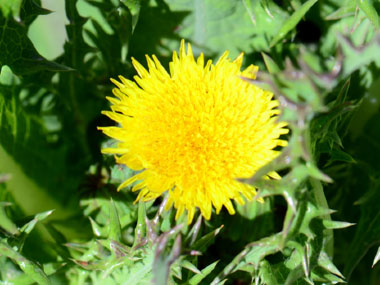






To support our efforts please browse our store (books with health benefits, etc.).
Prickly sowthistle is an annual or biennial plant that is in the Asteraceae family. In some areas it may also be known as the Rough Milk Thistle, or Sharp-fringed Sowthistle. The genus “Sonchus” is Greek for Sowthistle. The genus Sonchus was published in 1753 by Carl Linnaeus, (1707-1778). The species epithet “asper” is derived from asper, “rough,” and used for a plant with rough or prickly leaves. It is native to Europe, West Asia, and North Africa. Spiny sowthistle was introduced to North America, South America, East Asia, South Africa, Australia, and New Zealand. Each plant produces 20,000 to 26,000 seeds. Seeds can survive between two and eight years in the soil.
Distinguishing Features
Prickly sowthistles have green shiny leaves with prickly margins that do not hurt. Leaves clasp the stem. Flowers are dandelion-like in appearance, and have up to 150 ligulate, yellow ray florets.
Flowers
The flower head, consisting of bracts, receptacle and ray flowers (petals), is thick, barrel to vase shaped, usually with tiny glandular hairs on the stalk just below the cluster. Flowers are yellow. Floral heads with ligulate florets look similar to the dandelion flower. Flower heads are on short bristly-glandular stalks. Each flower head is 1.5 to 2 cm (about 1")in diameter. Flowers bloom anytime from May well into autumn.
 Fields
of Nutrition has medicinal benefits and vitamin/mineral content of Spiny Sowthistle.
Fields
of Nutrition has medicinal benefits and vitamin/mineral content of Spiny Sowthistle.
Leaves
Leaves begin their growth as a basal rosette and can be confused with thistles. Leaves are lobed with prickly, wavy margins and they range from 6 to 30cm (2.5 to 12”) in length and 1 to 15cm (.5 to 6”) in width. They are thick, soft, and the bases of upper leaves clasp the stems. They are arranged alternately, and the blades are spatulate to lanceolate.
Height
Spiny sowthistle grows anywhere from 60cm to 1.25m (2 to 4'). Stems are lined or grooved, green or reddish, usually hairless, stout, hollow, crisp but brittle, and exude a milky sap when broken.
Habitat
This plant prefers sunny locations, roadsides, waste areas, fields, along streams, and in gardens. They can be found at sea level to 8,000 feet.
Edible Parts
Young leaves and stem tops can be consumed raw or cooked. They can be added to salads or in a sandwich. The leaves have a mild agreeable flavor. Although the stems are considered edible, they should be cut and the bitter-tasting milky sap washed out before eating or cooking them. Some people have peeled the stems and eaten raw like celery.
Other Name
Sharp-Fringed Sowthistle.
Similar Plants
Perennial Sow Thistle.
Winter Survival Food Handbook

PDF Plant Magazines
Types of Wild Food
Geographic Zones Seasons
Disclaimer
EdibleWildFood.com is informational in nature. While we strive to be 100% accurate, it is solely up to the reader to ensure proper plant identification. Some wild plants are poisonous or can have serious adverse health effects.
We are not health professionals, medical doctors, nor are we nutritionists. It is up to the reader to verify nutritional information and health benefits with qualified professionals for all edible plants listed in this web site. Please click here for more information.
Why Edible Wild Food?
- Food costs are rising
- Free, wild food is readily abundant
- Wild food adds nutrition to your diet
- Wild food can help treat various medical conditions







